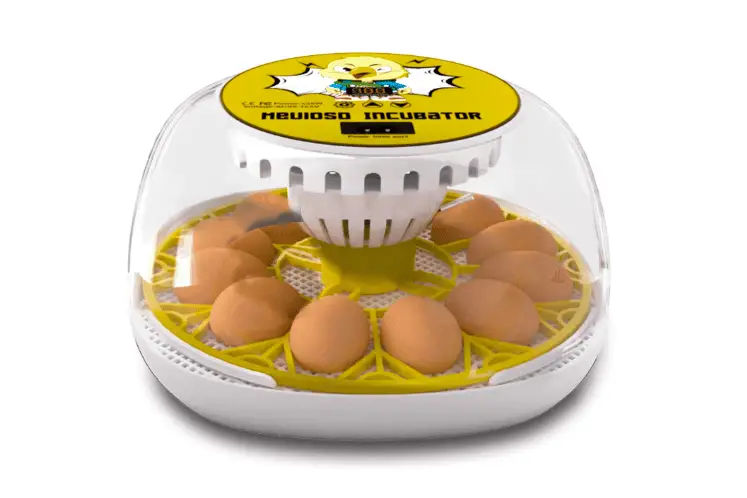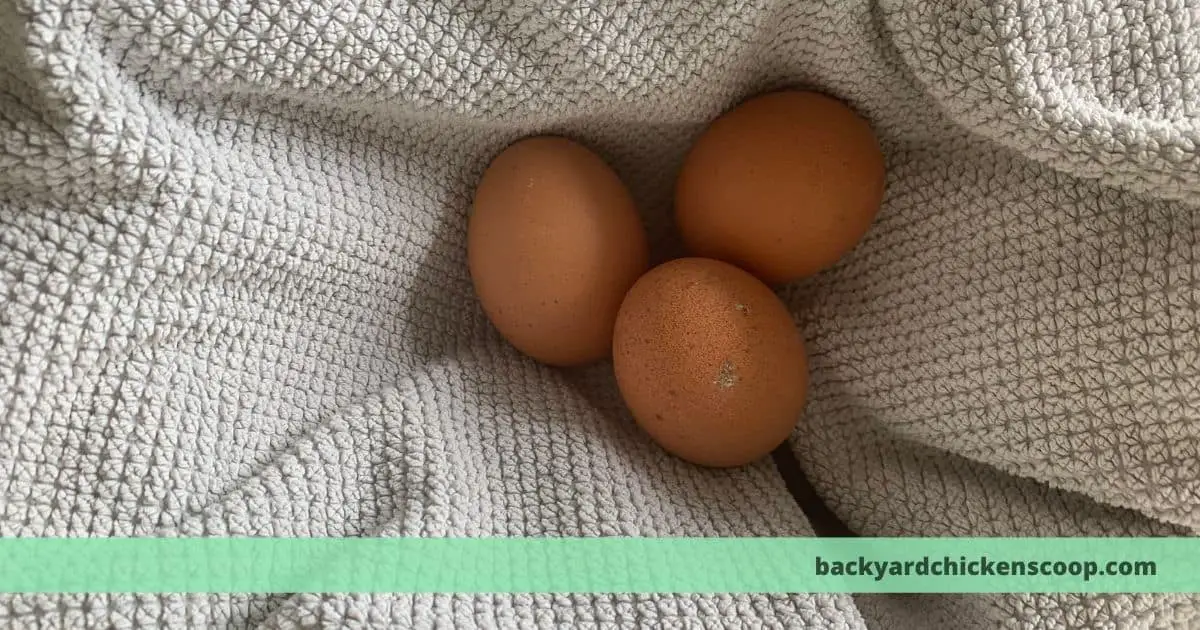Incubating eggs can be a tricky business for beginners. There are very specific conditions you need to maintain to ensure the highest hatch rates for your eggs. The window of appropriate temperatures is fairly small.
A temperature that is too cold, or especially one that is too hot, can have significant effects on how many of your eggs hatch. In this article, we’ll take a look at the perfect temperature to keep your eggs at, what can happen if the temperature gets too hot or too cold, and what you can do to ensure a high hatch rate.
Key Points In This Article
The optimal conditions for incubating and hatching chicken eggs involve maintaining specific temperature and humidity levels. Here’s a summary of the optimal conditions:
Maintaining these conditions is essential for achieving a high hatch rate. It’s also important to ensure that your incubator is well-ventilated and that the temperature and humidity are evenly distributed throughout the incubator. Regularly turning the eggs until the last three days before hatching is also crucial for proper development.
| Condition | Temperature (Celsius) | Humidity | Stage of Development |
|---|---|---|---|
| Incubation Temperature | 37.5 to 37.8 | N/A | Day 1 to Day 18 |
| Hatching Temperature (last 3 days) | 37.2 (optional adjustment) | N/A | Day 19 to Day 21 (Hatching) |
| General Incubator Temperature | 37.5 | N/A | Throughout incubation |
| Incubator Humidity | |||
| First 18 Days | N/A | 40-50% RH | Day 1 to Day 18 |
| Last 3 Days (Lockdown Period) | N/A | 65-70% RH | Day 19 to Day 21 (Hatching) |

What Is the Ideal Temperature and Humidity for Hatching Chicken Eggs?
There is a very small window for ideal temperature and humidity when hatching chicken eggs. That window changes slightly throughout the entire incubation period, which is generally going to be about three weeks or 21 days.
To start with, the temperature of your incubator should be about 99 degrees Fahrenheit to 102 degrees Fahrenheit or 37 degrees Celsius to 39 degrees Celsius.
Depending, of course, on the unit of temperature your thermometer uses. This temperature should be kept consistently, generally aiming for an average of 100 degrees Fahrenheit or 38 degrees Celsius, for about 18 days.
After 18 days, the temperature should be lowered ever so slightly to around 98.5 degrees Fahrenheit or just below 37 degrees Celsius.
The lowered temperature makes up for the increased heat that comes from the egg embryos before hatching.
It is never a good idea to aim for higher temperature levels in an attempt to get your chicks to hatch faster. Patience is required, and you need to allow the natural cycle to do its thing. Otherwise, you’ll be in for a higher mortality rate when your eggs hatch.
Always aim for the middle of the road in the temperature window, and keep careful track of the temperature in case of any errors or fluctuations. Also, be sure that your incubator is kept in an area without extreme temperature fluctuations. External temperature fluctuations can greatly affect the sustainability of the temperature in your incubator. Direct sunlight is a no-go, so you will want to keep your incubator in a shady environment with a stable temperature.
As for humidity, you should generally aim to keep the humidity level between 50% and 55% for those initial 18 days. After 18 days, you’ll raise the humidity level to about 65% at the same time as you slightly lower the temperature. This increased humidity level keeps the chicks from getting stuck on the egg membrane as they’re beginning to hatch.
Humidity can be adjusted by simply placing a container of water below the egg tray and decreasing and increasing the ventilation until the desired humidity range is reached. Many incubators will also have trays included in the design where water can be added to increase humidity.
How Do I Adjust the Temperature on my Incubator?
Your incubator’s temperature should be controlled by a thermostat, which often consists of a screw that will be turned either counter-clockwise to increase heat or clockwise to decrease heat. Incubator’s control mechanisms can vary, though, so be sure to check your instruction manual. Many more modern incubators will use digital controls that make temperature adjustment a lot easier.
It is important that you set up the incubator and set the temperature a few days before you are going to be placing your eggs in, as this will allow you to make sure that the temperature is stable and adjust for any fluctuations. Once you’ve got the eggs in, be sure to check the temperature and humidity levels several times a day to make sure that everything is the way it should be.
However, allow a two-day window after first placing the eggs where you don’t increase the temperature, as the eggs need to stabilize with the temperature of the incubator, and this can make temperature reading difficult in the first 48 hours. If you’ve properly stabilized the temperature beforehand, things should even out between the eggs and the incubator after a day or two.
Overcompensating and increasing the temperature immediately after placing the eggs in can result in the temperature getting too high right out of the gate, which will make your eggs dead on arrival.
Over time, the temperature can go up as the heat coming from the eggs increases due to the growing embryos, so you’ll need to keep a careful eye to ensure that the temperature is never going above 102 degrees Fahrenheit or 39 degrees Celsius. Even just a few hours in too cold or too hot of temperature can affect the overall mortality rate of your eggs.

What Temperature Will Kill Chicken Eggs?
High temperatures are much more detrimental to the health of your eggs than cold temperatures, so you should be much more careful about keeping the temperature from getting high than you would be about keeping the temperature from getting cold. A temperature of 103 degrees Fahrenheit or just over 39 degrees Celsius for just a few hours can drastically increase the mortality rate of your eggs. Likewise, a temperature even higher than that for even just a fraction of an hour may make it so that only one or two of your eggs hatch, if any.
What Happens If Chicken Eggs Get Too Hot?
If chicken eggs get too hot, it need to be immediately rectified, otherwise, they likely won’t hatch. As we said in the prior section, a temperature just slightly higher than is allowed in the appropriate temperature window can result in serious problems after only an hour or two. Temperatures that greatly exceed 102 degrees Fahrenheit can do even more damage in a shorter amount of time. Be sure to keep a constant eye on the temperature of your incubator and never allow it to go over 102 degrees Fahrenheit, or even really get that close to it.
If you’ve discovered that your eggs have been sitting at over 102 degrees Fahrenheit for any amount of time, you should immediately attempt to cool them down by taking them out of the incubator and placing them in cool water. If you don’t have a container big enough, you can spray them with a hose. You’ll want to cool the eggs so that the shells are about 80 degrees Fahrenheit or 27 degrees Celsius. The shells will get cooler faster than the embryos, so aim low. Don’t be too worried about over-cooling, as lower temperatures are not nearly as detrimental as the higher ones.
While cooling off the eggs after they’ve been sitting for a time in higher temperatures isn’t a miracle fix, it’s the best that you can do given the situation. The hatch rate will likely have been affected at least slightly, but you’ll still have made it better than it would have been without cooling them down. If you are curious, you can candle your eggs to see if there is any movement inside and also to check for veins.
Candling eggs simply entail illuminating the inside of the egg by placing the egg on a powerful light source that makes the shell see-through. If the embryo has died, there will be no movement and the veins will generally disintegrate. Otherwise, put your eggs back in the incubator and hope for the best outcome when it’s hatching time. And be sure to continue keeping an eye on the temperature multiple times a day!
Will Eggs Still Hatch If They Get Cold?
Eggs can typically hatch after they’ve been in colder temperatures for short periods, but it might still affect the hatch rate slightly. A few hours in colder, and sometimes even freezing, temperatures can often have little to no effect on the mortality rate so long as the problem is taken care of soon enough. Because of this, you shouldn’t be too worried if your incubator gets unplugged or turned off accidentally for only an hour or two. Just plug it back in or turn it back on and everything should stabilize.
The biggest issue that cold temperatures pose to your eggs is if they crack from freezing. Your egg won’t hatch if it’s cracked. If your eggs have been in very cold temperatures, it is ideal to let them sit at room temperature for about a day before placing them back in the incubator, as you don’t want any extreme temperature fluctuations messing with the integrity of the egg.

How Long Can Incubated Eggs Be Cold?
Just a few hours is the safest bet for how long incubated eggs can be in colder temperatures, although the less time, the better. There can be situations in which several more hours can be added to that window with little to no effect on the hatch rate, it all depends on how cold the temperature is and how far along the eggs are.
As we said, finding out that your incubator has turned off for a few hours in not too extreme of a low temperature isn’t that big of a deal. A small period at a lower temperature likely won’t affect the hatch rate. However, it’s always best to play it safe and routinely check the temperature of the incubator. Power outages can also be an issue, as in some cases power outages can last for a good deal more than a couple of hours. Keeping your incubator hooked up to a backup generator is a good solution for this.


